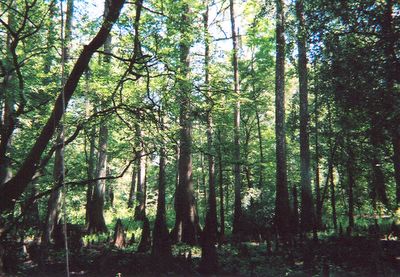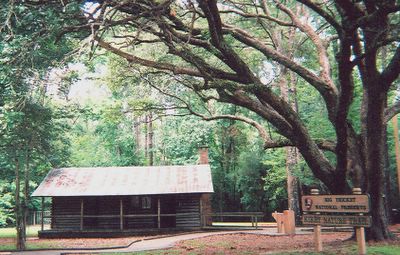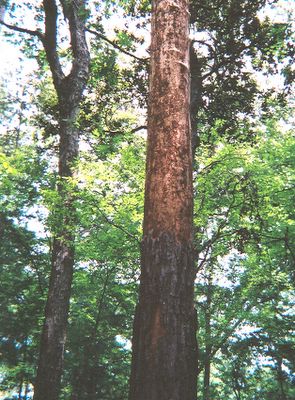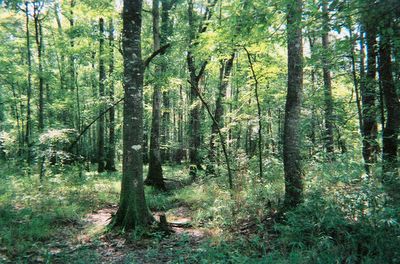Into The Thicket
Bottomland Forest, Turkey Creek Trail

Yesterday I took a long walk in the Big Thicket. It's my impression that few birders ever spend much time deep in the thicket, and even fewer visit the preserve in summer, when conventional wisdom is that it's too hot, too buggy, too well populated with venemous snakes, and the birds are too hard to find.
There's no denying that it was hot and uncomfortably humid, but at least I was in the deep shade of the forest most of the time. Fortunately the bugs weren't as awful as I expected. I got a few chigger bites, but deerflies were mercifully few, and repellent kept the mosquitoes at bay. More annoying were the large spider webs that frequently spanned the trail, and I resorted to carrying a hefty stick to knock them out of my way. I didn't see a single snake.
As for the birds, they were plentiful and surprisingly vocal. Although late in the breeding season, and already approaching noon when I began my hike, there were still some birds singing.
The Trailhead

I started with the Kirby Nature Trail at the southern end of the Turkey Creek Unit. Back in the 1960s, prior to the establishment of the Big Thicket National Preserve, there were reports of Ivory-billed Woodpecker from this area, and this is where John Dennis recorded what were purported to be IBW calls in 1968 (experts dispute whether the taped calls were produced by an actual IBW or by a Blue Jay imitating an IBW).
I wanted to visit a place where an IBW may have been present in the recent past (if 37 years ago counts as recent!). I saw a few big cypresses and tupelos, but like most of the Big Thicket the forest had been cutover, the virgin timber was long gone, and what was left would provide marginal IBW habitat at best.
Of course I didn't really expect to find an IBW - not along a well maintained trail with bridges and benches and numbered markers and plaques identifying the trees. The Turkey Creek Trail is the most popular hiking trail in the preserve, and it would be almost impossible for IBWs to go unnoticed along such a heavily travelled path. No, if there are still any IBWs in the Big Thicket they won't be found so easily. More likely places to search would be the extensive swamps along the Neches and Sabine Rivers, and even there it's extremely doubtful that such a large bird could remain hidden all these years - there are simply too many people kayaking and canoeing on the rivers for someone not to notice at some point. I want to believe, but the facts don't offer much hope.
Not only did I fail to find an IBW, but in several miles of hiking I didn't see or hear a single Pileated Woodpecker! This seems a bit odd, since the area featured a plenitude of big snags and fallen timber - perfect Pileated Woodpecker habitat. I did see one dead tree that was almost completely stripped of bark, with big chunks piled at its base. Evidence of an IBW at work? Doubtful. But if such a tree had been found in an area where IBWs are believed to be present, such as N.E. Arkansas, it might generate some excitement.
Obviously the Work of An Ivory-billed Woodpecker...NOT!

So I didn't come across any big woodpeckers, but there were plenty of other birds. Acadian Flycatchers, Carolina Wrens, and Hooded Warblers were common in the swampy woods. Red-eyed and White-eyed Vireos were still singing along the trail, and by following a series of loud chips I found a pair of Swainson's Warblers lurking in the undergrowth and leaf litter.
Typical Forest Community, Turkey Creek Trail

Due to the dense vegetation I heard far more birds than I was able to see, and by careful listening I was also able to detect Yellow-billed Cuckoo, Great Crested Flycatcher, Wood Thrush, and Summer Tanager. As I walked back toward the trailhead a couple of Barred Owls commenced hooting and cackling...there is no wilder sound than a pair of Barred Owls dueting. I didn't encounter any other hikers, and the only other large mammals I saw were a couple of White-tailed Deer that I spooked. In places the forest floor was torn up as if by a rototiller - probably the work of feral pigs or wild boar.
In the evening I spent some time watching the sky over my backyard for whatever might fly over...which included a Little Blue Heron, Chimney Swifts, and Purple Martins. A Hooded Warbler flitting through the trees at dusk was a nice surprise.


0 Comments:
Post a Comment
<< Home